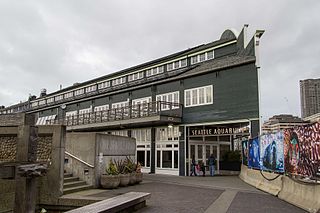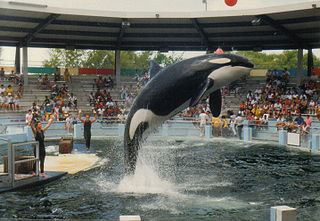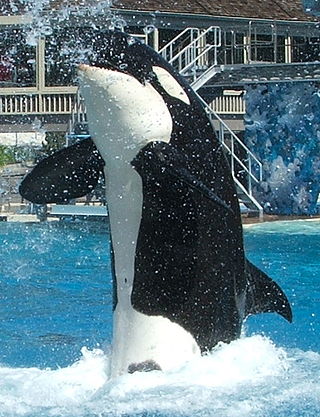History
The aquarium opened on June 22, 1962, during the Century 21 Exposition and was initially owned and operated by Ted Griffin. At the time he hoped that his aquarium would be a "prelude" to a Marineland. The aquarium was a 6,000 square foot building. The staff consisted of skin-divers and volunteers. The curator was Eric Friese. [1]
In 1965, the aquarium was contacted by Canadian fishermen who had accidentally trapped an orca. Ted Griffin thus acquired his first orca for $8,000, and named him Namu for the area where he was captured. [2] Namu survived a year in Griffin's hands.
The aquarium closed on September 12, 1976, due to the forthcoming opening of the city-built Seattle Aquarium on Pier 59. [3]

The orca, or killer whale, is a toothed whale that is the largest member of the oceanic dolphin family. It is the only extant species in the genus Orcinus. Orcas are recognizable by their black-and-white patterned body. A cosmopolitan species, orcas are found in diverse marine environments, from Arctic to Antarctic regions to tropical seas.

The Seattle Aquarium is a public aquarium in Seattle, Washington, United States, located on Pier 59 on the Elliott Bay waterfront. It opened in 1977 and has been accredited by the Association of Zoos and Aquariums (AZA).
Shamu was a female orca captured in October 1965 from a southern resident pod. She was sold to SeaWorld San Diego and became a star attraction. Shamu was the fourth orca ever captured, and the second female. She died in August 1971, after about six years of captivity. After her death, the name Shamu continued to be used in SeaWorld "Shamu" shows for different orcas in different SeaWorld parks.

Orca is a 1977 American thriller film directed by Michael Anderson and produced by Dino De Laurentiis, starring Richard Harris, Charlotte Rampling and Will Sampson. The film follows a male orca tracking down and getting revenge on a fishing boat and its captain for killing the whale's pregnant mate and their unborn calf.

Lolita, also known as Tokitae, or Toki, and as Sk’aliCh’ehl-tenaut in the Lhaq’temish language of the Lummi nation, was a captive female orca from the southern resident orca community. She had been in captivity at the Miami Seaquarium in the United States since September 24, 1970. At the time of her death, Lolita was the second-oldest orca in captivity after Corky at SeaWorld San Diego.

The Miami Seaquarium is a 38-acre (15 ha) oceanarium located on the island of Virginia Key in Biscayne Bay, Miami-Dade County, Florida located near downtown Miami.

Dolphin drive hunting, also called dolphin drive fishing, is a method of hunting dolphins and occasionally other small cetaceans by driving them together with boats, usually into a bay or onto a beach. Their escape is prevented by closing off the route to the open sea or ocean with boats and nets. Dolphins are hunted this way in several places around the world including the Solomon Islands, the Faroe Islands, Peru, and Japan, which is the most well-known practitioner of the method. In large numbers dolphins are mostly hunted for their meat; some end up in dolphinariums.
Namu was a male orca unintentionally captured in 1965 from the C1 Pod of the northern resident community. He was the first captive orca to perform with a human in the water. He was the subject of much media attention, including a starring role in the 1966 film Namu, the Killer Whale. Namu's captivity introduced thousands of people to orcas, and soon aquariums all over the world sought to establish captive orcas in their parks.

L98 Luna also known as Tsux'iit, was a killer whale (orca) born in Puget Sound. After being separated from his mother while still young, Luna spent five years in Nootka Sound, an ocean inlet of western Vancouver Island, where he had extensive human contact and became recognized internationally.

Springer, officially named A73, is a wild orca from the Northern Resident Community of orcas, which frequents the waters off the northern part of Vancouver Island every summer. In January 2002, Springer, then a calf developmentally equivalent to a human toddler, was discovered alone and emaciated some 250 miles from the territory of her family. Experts identified Springer by her vocal calls that are specific to her family, or "pod," and by examining photographs of her eye patch. They were also able to determine where Springer's pod was currently located.

Dozens of orcas are held in captivity for breeding or performance purposes. The practice of capturing and displaying orcas in exhibitions began in the 1960s, and they soon became popular attractions at public aquariums and aquatic theme parks due to their intelligence, trainability, striking appearance, playfulness, and sheer size. As of 1 January 2024, around 58 orcas are in captivity worldwide, 34 of which were captive-born. At that time, there were 18 orcas in the SeaWorld parks.
Captured in 1964, Moby Doll was the first orca to survive in captivity for more than two days, and the second to be displayed in a public aquarium exhibit. The availability, for the first time, of an orca that could be studied at close quarters alive initiated pioneering research. From a recording of Moby Doll's calls, he was years later identified as a member of J Pod of the southern resident orcas.

The southern resident orcas, also known as the southern resident killer whales (SRKW), are the smallest of four communities of the exclusively fish-eating ecotype of orca in the northeast Pacific Ocean. The southern resident orcas form a closed society with no emigration or dispersal of individuals, and no gene flow with other orca populations. The fish-eating ecotype was historically given the name 'resident,' but other ecotypes named 'transient' and 'offshore' are also resident in the same area.
Edward Irving "Ted" Griffin is an American former aquarium owner and entrepreneur who was the first man to ever swim with a killer whale in a public exhibition, with the whale named Namu. He is best known for capturing, performing with, and selling a number of orcas during the late 1960s and early 1970s.

Shamu was the stage name used for several captive performing orcas at SeaWorld as part of their theatrical Shamu show beginning in 1960s. The original Shamu died in 1971, but the name was trademarked by SeaWorld, and has been given to different orcas over the years.

Granny, also known as J2, was a female orca of the J pod of southern resident orcas notable for her long life. Early estimates placed her birth in 1911, putting her at 105 years old at the time of her death. However, this estimate was later theorized to have been based on mistaken information and more recent studies put her at 65–80 years old. If she was 105, she would have been the oldest known orca at the time of her death. Granny lived in the northeast Pacific Ocean and coastal bays of Washington state and British Columbia. She was last seen on October 12, 2016, and was considered deceased by The Center for Whale Research in January 2017.
Walter the Whale (Skana) was a star orca (killer whale) during the early era of captive orcas in the 1960s. In 1967, following the death of Namu, the only other established star orca was Shamu. Walter the Whale was the orca's advertised name at first, but she was later renamed Skana.
Moby Doll, who in 1964 in British Columbia became the second ever captive orca, was the first orca to be studied scientifically at close quarters alive.
The Yukon Harbor orca capture operation was the first planned, deliberate trapping of a large group of orcas. 15 southern resident orcas were trapped by Ted Griffin and his Seattle Public Aquarium party on 15 February 1967, in Yukon Harbor on the west side of Puget Sound. The first four orcas that had been taken into captivity had been captured singly, and mostly opportunistically. Those four were named Wanda, Moby Doll, Namu, and Shamu—who was then the only surviving one. Through them, interest in orcas had escalated.












